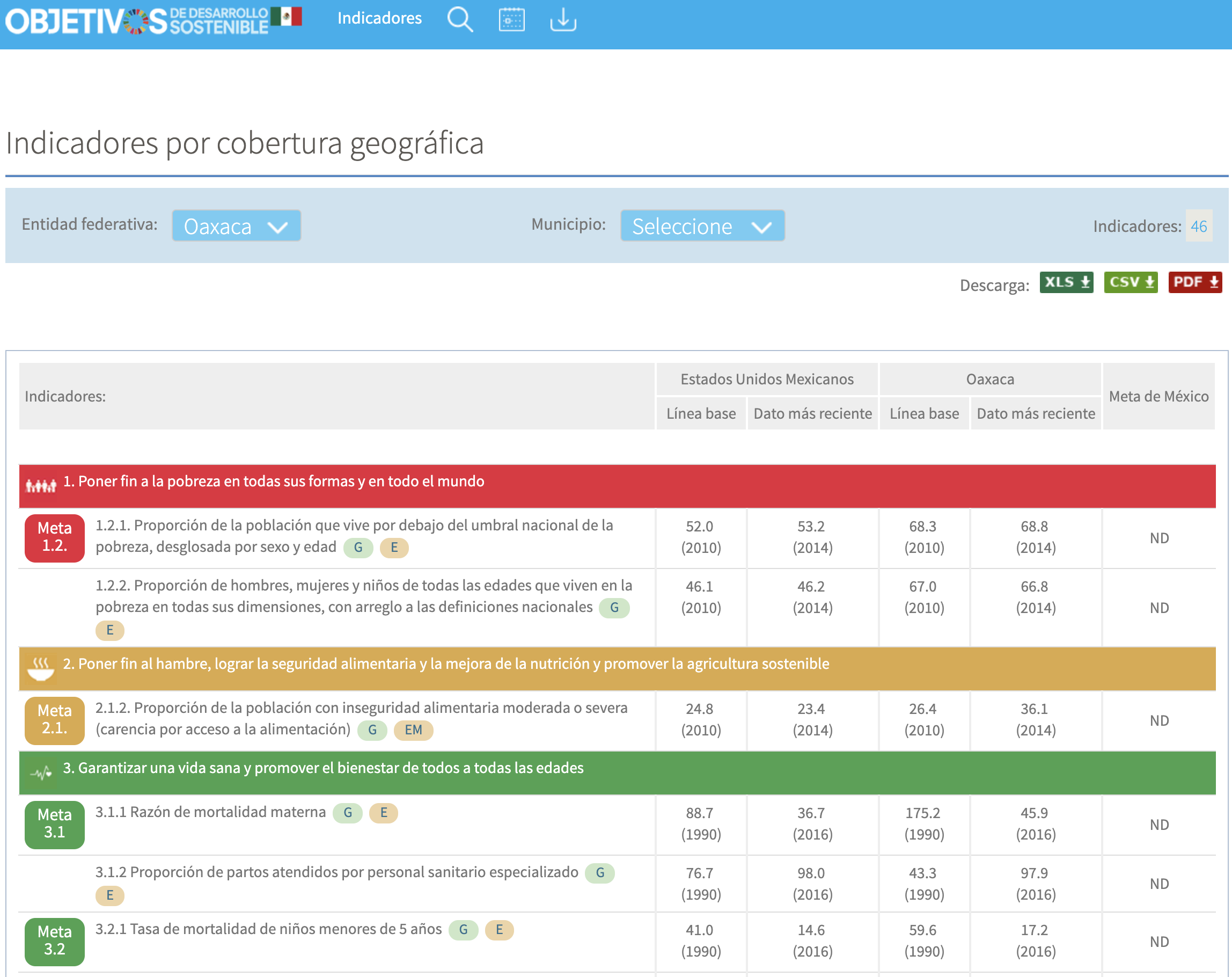
Since their establishment in 2015, the Sustainable Development Goals (SDGs) have become the leading international agenda to promote social, economic and environmental development. The 2030 Agenda has encouraged the construction of numerous development indicators through which governments can track and evaluate their progress towards the SDGs. For example, the United Nations provides open access to the official SDG database; alternatively, the World Bank has collected enough indicators to build an ˜unofficial’ SDG database; and countries like Mexico are producing comprehensive indicators at the subnational level (agenda2030.mx). Indicators, however, are only one side of the development equation: they constitute the output. However, realistic strategies to reach specific goals of a government cannot be properly designed without information about the input side: public expenditure.

To a reasonable degree, a government’s development strategy can be captured by its allocation of resources across different policy issues. The aim of such strategies is transforming the relevant indicators to, eventually, reach the government’s goals. Ironically, while we have plenty development-indicator data, there is scant information on public expenditure. However, in recent years, the Global Initiative for Fiscal Transparency (GIFT) has been trying to change this shortfall. But, even if fiscal data would become available, the complexity of the policymaking process obfuscates our understanding on how public expenditure translates into development outcomes. This is so because, for example, government agencies may have different goals from those of the central authority (misalignment of incentives), there may be inefficiencies due to corruption or lack of capacity and, on top of that, there are spillover effects between public policies (synergies and trade-offs). Fortunately, cutting-edge Artificial Intelligence (AI) research is trying to cope with this challenge. In this post, we argue that these technological advances in conjunction with open fiscal data can enable governments to fully exploit SDG indicators in the pursuit of worldwide development. For this reason, it is crucial that governments focus their efforts in two fundamental tasks: (1) producing granular open fiscal data and (2) linking it to development indicators.
AI for Sustainable Development
At The Alan Turing Institute, we are developing the computational framework of Policy Priority Inference (PPI). PPI builds on a behavioral model of the policymaking process. Among the most relevant aspects considered, we can find the learning process of public officials, coordination problems, incomplete information, and imperfect monitoring mechanisms. PPI simulates the complex and uncertain dynamics observed in development-indicator data. In parallel, it takes into account the network of interdependencies between development indicators, which describes positive and negative policy spillover effects. The method can be used with datasets that have more indicators than observations; such as those built by most governments. Likewise, it does not require an insurmountable collection of information, so it is scalable to big or small data.
The innovation of using an AI tool such as PPI is that, by explicitly modeling the policymaking process that generates development indicators, we can simulate data that is not observable in the real world. One such data is precisely public expenditure on SDGs. In addition, PPI can also estimate, at the level of each indicator, how efficiently are the resources being used. In a recent paper (arxiv.org/abs/1902.00430), we use this technology to measure policy coherence, a topic that has not been properly quantified and yet, is central to multilateral organizations such as the OECD (oecd.org/gov/pcsd). PPI reproduces empirical development indicators and, as a byproduct of its behavioral model, it simulates the distribution of resources that gives place to the observed indicator dynamics. We use these distributions to construct a policy coherence index that can be used to compare how consistent are the policy priorities of a government in relation to its development goals. Our index can be extremely valuable to assess how committed are governments towards the 2030 Agenda “or any other “ and to identify those policy issues that should be prioritized.
AI + Open Fiscal Data
So, in absence of open fiscal data, PPI simulates budgetary allocations that generate real-world development indicators. However, we can do much better if we feed this technology with public expenditure data. For example, if governments provide a detailed account of their allocations at the level of each development indicator, PPI can be tuned to match those expenditure patterns. This would represent a major improvement in the estimation of policy priorities. To get a clear picture of why this would be the case, let us provide some context on the tools that are currently being used to advise governments.
Traditionally, development consultants have attempted to approximate the effects of improving specific indicators by measuring their level of association. That is, by looking at metrics such as correlations or regression coefficients, analysts try to disentangle how, for example, improvements in the aquatic environment (SDG 14) relate to changes in GDP growth (SDG 8). These associations, while illustrative, are not informative about how to produce environmental improvements. In other words, by solely focusing on the output side of the problem (indicator data), we can only learn how an indicator in SDG 14 relates to another one in SDG 8, not how a specific budget program translates into effective policy contributions, then into development, and subsequently into spillovers. Ironically, the whole point of providing policy advice is to know the instruments that have dedicated recourses, i.e. the input side. In principle, public expenditure data can ease this problem. This is why AI tools such as PPI are so important to produce reliable policy advice.
Going back to our main discussion, open fiscal data plays a crucial role for the SDG policy prioritization through AI. This shows the importance of making fiscal data publicly available, an endeavor that GIFT has pursued forcefully in the last decade. There is, however, an additional challenge that needs to be tackled: linking expenditure to SDGs. As we have explained, the output side of the development process consists of indicators, not expenditure programs. This translates into a mismatch between inputs and outputs, something that requires the attention of every government. The Mexican government, for example, assembled a team of specialists from the Treasury and from the United Nations Development Program to produce the first fiscal-SDG linked data in the world. This experience should provide guidelines to other countries that are serious in attempting to reach the 2030 Agenda.

The Future of Open Fiscal Data
A systematic effort to publish fiscal data and link it to development indicators is necessary if governments want to exploit AI for reliable policy advice. Nevertheless, there will still be other challenges ahead that need to be overcome. One of them is that, even if comprehensive fiscal-SDG linked data becomes available, we need to identify transformative expenditure. That is, just because we observe a substantial amount of resources in a specific policy issue, it does not mean that those resources correspond to transformative policies (those that improve indicators). The best example is the highway infrastructure of the industrialized nations. In these countries, extensive road networks have already been created, so most if the expenditure in this topic is dedicated to maintain them. Thus, indicators such as road coverage will not change as a result of this expense. In contrast, a developing country where new highways are being constructed is effectively devoting resources to produce a transformation, pushing the relevant indicator upwards. In one of our papers, we have found a related “and paradoxical “ example in the topic of education. While developing countries have not prioritized this issue (which they urgently need to do), the developed nations keep investing to transform it (e.g., Finland is currently transforming its curricula in profound ways: ind.pn/2wfIgdB).
In conclusion, if governments are serious about meeting the SDGs by 2030, or any other future development agenda, they need to embrace what AI methods have to offer and combine them with development-indicator data. However, these efforts will eventually reach a bottleneck if governments only care about the output side of development. Thus, it is crucial to start building data for the input side, in particular, fiscal-SDG linked data. Only then, governments will be able to take advantage of the current technological revolution when designing and implementing policies.
For countries interested in applying for this model, who are committed to opening their public spending data and advance the link between the budget and SDGs, contact GIFT Coordination Team through lorena@fiscaltransparency.net.
Bios
Omar A. Guerrero (@guerrero_oa) is a Senior Research Fellow at the Department of Economics in University College London and at The Alan Turing Institute, the UK’s national institute for data science and AI. He has been a fellow at the Oxford Martin School, the Saïd Business School and the Institute of New Economic Thinking at the University of Oxford. Currently, Omar works in the intersection of development economics and sustainability, trying to understand how policy priorities translate into effective development. For this, he employs techniques such as agent-computing models, machine learning and natural language processing.
Gonzalo Castañeda is Professor in Economics at the Center for Research and Teaching in Economics (CIDE), Mexico. He is also a member of the National Research System, level III (i.e., the top rank granted by the National Council of Science and Technology). Gonzalo works on Complex Adaptive System with issues related to economic development, and has a forthcoming book written in Spanish and English with the title œSocial Complexity: An Innovative Approach for Understanding Socioeconomic Phenomena .

